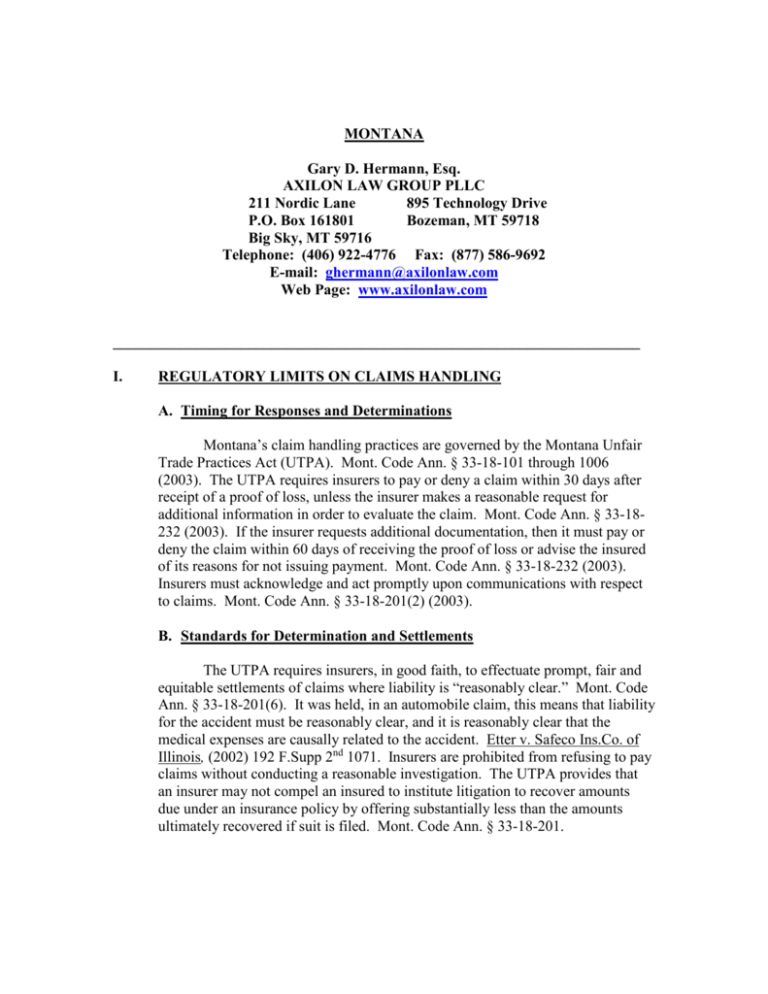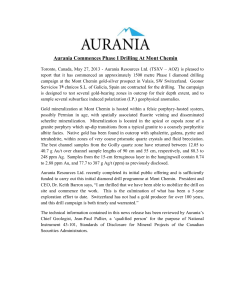MONTANA Gary D. Hermann, Esq. AXILON LAW GROUP PLLC 211
advertisement

MONTANA Gary D. Hermann, Esq. AXILON LAW GROUP PLLC 211 Nordic Lane 895 Technology Drive P.O. Box 161801 Bozeman, MT 59718 Big Sky, MT 59716 Telephone: (406) 922-4776 Fax: (877) 586-9692 E-mail: ghermann@axilonlaw.com Web Page: www.axilonlaw.com ______________________________________________________________________ I. REGULATORY LIMITS ON CLAIMS HANDLING A. Timing for Responses and Determinations Montana’s claim handling practices are governed by the Montana Unfair Trade Practices Act (UTPA). Mont. Code Ann. § 33-18-101 through 1006 (2003). The UTPA requires insurers to pay or deny a claim within 30 days after receipt of a proof of loss, unless the insurer makes a reasonable request for additional information in order to evaluate the claim. Mont. Code Ann. § 33-18232 (2003). If the insurer requests additional documentation, then it must pay or deny the claim within 60 days of receiving the proof of loss or advise the insured of its reasons for not issuing payment. Mont. Code Ann. § 33-18-232 (2003). Insurers must acknowledge and act promptly upon communications with respect to claims. Mont. Code Ann. § 33-18-201(2) (2003). B. Standards for Determination and Settlements The UTPA requires insurers, in good faith, to effectuate prompt, fair and equitable settlements of claims where liability is “reasonably clear.” Mont. Code Ann. § 33-18-201(6). It was held, in an automobile claim, this means that liability for the accident must be reasonably clear, and it is reasonably clear that the medical expenses are causally related to the accident. Etter v. Safeco Ins.Co. of Illinois, (2002) 192 F.Supp 2nd 1071. Insurers are prohibited from refusing to pay claims without conducting a reasonable investigation. The UTPA provides that an insurer may not compel an insured to institute litigation to recover amounts due under an insurance policy by offering substantially less than the amounts ultimately recovered if suit is filed. Mont. Code Ann. § 33-18-201. C. Privacy Protection (In addition to Federal Gramm-Leach-Bliley Act) The Insurance Information and Privacy Protection Act (Mont. Code Ann. § 33-19-201 through 409 (2003) establishes standards for the collection use and disclosure of information gathered in connection with insurance transactions by insurance institutions. This act was passed in 1981 and is based on the model Act drafted by the National Association of Insurance Commissioners. The Act was amended in 2001 to provide privacy protection consistent with federal law. In Montana, the interpretation of an insurance contract is a question of law. When a court reviews an insurance policy, it is bound to interpret its terms according to their usual, common sense meaning as viewed from the perspective of a reasonable consumer of insurance products. Counterpoint, Inc. v. Essex Ins. Co., 1998 MT 251, 13, 291 Mont. 189, 967 P.2d 393. Exclusions from coverage are to be narrowly and strictly construed because they are contrary to the fundamental protective purpose of an insurance policy. Swank Enters., Inc. v. All Purpose Servs., Ltd., 2007 MT 57, 27, 336 Mont. 197, 154 P.3d 52. When an insurance policy is ambiguous, it is to be interpreted most strongly in favor of the insured and any doubts as to coverage are to be resolved in favor of extending coverage for the insured. Mitchell v. State Farm Ins. Co., 2003 MT 102, 26, 315 Mont. 281, 68 P.3d 703. An ambiguity exists where the insurance contract, taken as a whole, is reasonably subject to two different interpretations. Id. II. PRINCIPLES OF CONTRACT INTERPRETATION In Montana, the interpretation of an insurance contract is a question of law. When a court reviews an insurance policy, it is bound to interpret its terms according to their usual, common sense meaning as viewed from the perspective of a reasonable consumer of insurance products. Counterpoint, Inc. v. Essex Ins. Co., 1998 MT 251, 13, 291 Mont. 189, 967 P.2d 393. Exclusions from coverage are to be narrowly and strictly construed because they are contrary to the fundamental protective purpose of an insurance policy. Swank Enters., Inc. v. All Purpose Servs., Ltd., 2007 MT 57, 27, 336 Mont. 197, 154 P.3d 52. When an insurance policy is ambiguous, it is to be interpreted most strongly in favor of the insured and any doubts as to coverage are to be resolved in favor of extending coverage for the insured. Mitchell v. State Farm Ins. Co., 2003 MT 102, 26, 315 Mont. 281, 68 P.3d 703. An ambiguity exists where the insurance contract, taken as a whole, is reasonably subject to two different interpretations. Id. III. CHOICE OF LAW Montana Supreme Court claims that when faced with a choice-of-law conflict in contract disputes, they follow the "most significant relationship" approach contained in the Restatement (Second) of Conflict of Laws to determine the applicable state law, but, in fact, the Court has refused on a number of occasions to follow those rules where application of the law of the state chosen in the policy would be contrary to Montana public policy – especially when an insurer has attempted to make a subrogation claim. Youngblood v. American States Ins., 262 Mont. 391 (1993); Keystone v. Triad Systems, Inc., 1998 MT 326, 292 Mont. 229; Swanson v. Hartford Ins. Co., 2002 MT 81, 309 Mont. 269. The Court acknowledged the inconsistency in Moodro v. Nationwide Mut. Fire Ins. Co., 2008 MT 275, and attempted to clarify their position by stating that it will not apply the law of the state chosen by the parties if three factors are met: (1) if, but for the choice-of-law provision, Montana law would apply under § 188 of the Restatement; (2) if Montana has a materially greater interest in the particular issue than the state chosen by the parties; and (3) if applying the state law chosen by the parties would contravene a fundamental policy of Montana. IV. DUTIES IMPOSED BY STATE LAW A. Duty to Defend 1. Standard for Determining Duty to Defend An insurer’s duty to defend is determined by the language of the insurance policy. Coverage is based upon the acts giving rise to the claim, not necessarily the language of the policy. Brabeck v. Employers’ Mut. Cas. Co., 2000 MT 373, 303 Mont. 468, 470-471, 16 P.3d 355, 357 (citations omitted). To determine whether an insured’s obligation is “triggered, the court must liberally construe the allegations in the complaint, resolving all doubts about the meaning of the allegations in favor of finding the duty to defend was “triggered.” Grindheim v.Safeco Ins. Co., 908 F. Supp. 794; St. Paul Fire & Marine Ins. Co. v. Thompson, 150 Mont. 182 (1967). “Where a complaint alleges facts which represent a risk outside the coverage of the policy but also avers facts which, if proved, represent a risk covered, the insurer is under a duty to defend.” Atcheson v. Safeco Insurance Co. (1974), 165 Mont. 239, 245-46, 527 P.2d 549, 552. 2. Issues with Reserving Rights An insurer has an obligation to inform the insured of all policy defenses it intends to rely upon. Portal Pipe Line Co. v. Stonewall Ins. Co. (1993) 256 Mont. 211, 217, 845 P.2d 746, 750 (citing Mont Code Ann § 33-18-201(14)). If an insurer, without a reservation of rights, assumes exclusive control of the defense, it cannot thereafter withdraw and deny liability under the policy on grounds of lack of coverage. Prejudice to the insured is exclusively presumed by the loss of the insured’s right to control and manage the case. Portal Pipe Line Co., 256 Mont. at 211, 485 P.2d at 746. The Supreme Court has said that the way for an insurer to protect itself is to defend its insured under a reservation of rights and then seek a determination of rights through a declaratory action. Farmers Mut. Ins. Co. v. Staples, 321 Mont. 99 (2004). 3. Problems with insurer controlling the defense Montana severely limits the right of an insurance company to control the defense. In the case of In Re Rules of Professional Responsibility and Insured Billing Rules and Procedures, 299 Mont. 321 (2004), the Montana Supreme Court stated that an insured is the client of defense counsel appointed by the insurer and not the insurer, and that the insurer may not do anything which may interfere with defense counsel’s independent judgment. Thus, billing guidelines that require prior approval of actions or otherwise restrict the scope of defense counsel’s representation are considered a violation of the Rules of Professional Responsibility and thereby impermissable. B. Duty to Settle An insurer has a duty to attempt in good faith to effectuate prompt, fair, and equitable settlements when liability is reasonably clear. Mont. Code Ann. § 33-18-203(6). Insurers are prohibited from failing to settle claims under one portion of the policy in order to influence settlements under other portions of the policy. Mont. Code Ann. § 33-18-203(13). Insurers are obligated to pay, in advance of settlement, reasonable and necessary expenses incurred by a claimant as a result of the accident when liability for those expenses is “reasonably clear.” Ridley v. Guaranty Nat. Ins. Co., 286 Mont. 325, 951 P.2d 987 (1997); Dubray v. Farmers Ins. Exchange, 2001 MT 251, 307 Mont. 134, 36 P.3d 897, ¶¶ 14-15. On the other hand, the court has acknowledged that this obligation to pay “does not mean that an insurer is liable for all expenses submitted by an injured plaintiff” unless liability for that expense is also reasonably clear.” Ridley v. Guaranty Nat. Ins. Co. Id. Additionally, the Montana Supreme Court has held that a general release of the insurer or insured is not required by UTPA as a condition to settlement. Shilhanek v. D-2 Trucking, Inc., 2003 MT 122, 315 Mont. 519, 528, 70 P.3d 721, 727. V. EXTRACONTRACTUAL CLAIMS AGAINST INSURERS: ELEMENTS AND REMEDIES A. Bad Faith 1. First Party Mont. Code Ann. § 33-18-242(3) actually prohibits an insured from suing their insurer for common law “bad faith” over the handling of an insurance claim. (2003). An insured who has suffered damage as a result of the handling of an insured claim, however, is permitted under the statute to bring an action against an insurer for a number of improper practices including: breach of contract, fraud; misrepresentation of pertinent facts or policy provisions; refusal to pay claims without conducting a reasonable investigation based upon all reasonable information; failure to affirm or deny coverage within a reasonable time after proof of loss statements have been provided; and a failure to attempt in good faith to effectuate prompt, fair, and equitable settlements when liability is reasonably clear, if an insurer attempts to settle claims on the basis of an application which was altered without notice to or consent of the insured; failure to promptly settle claims if liability has become reasonably clear under one portion of an insurance policy in order to influence settlements under other portions of the policy. Mont. Code Ann. § 33-18-242 (read in conjunction with Mont. Code Ann. § 33-18201(1), (4), (5), (6), (9), (13) (2003)). It is not necessary for an insured to prove that the violations were of such frequency as to indicate a general business practice. Mont. Code Ann. § 33-18242(2). An unfair trade practices claim, however, is considered a cause of action which is independent from the underlying claim. As a result, a defense verdict in an underlying negligence claim against the insured does not in itself preclude an action against the insurer for violation of the UTPA. Graf v. Cont. W. Insur. Co. 321 Mont. 65, 89 P.3d 65 (2004). An insurer may not be held liable for unfair trade practices if the insurer had a reasonable basis in law or fact for contesting the amount of the claim, whichever is at issue. Bartlett v. Allstate Ins. Co., 280 Mont. 63, 70, 929 P.2d 227, 231. A claim of misrepresentation under the Fair Trade Practices Act.is determined by an objective analysis of the substance of the representation at issue, without regard to whether it resulted from an intentional effort to mislead, carelessness, incompetence or anything else. Lorang v. Fortis Insurance, 345 Mont. 12 (2008). 2. Third Party A third party has the same causes of action as stated above, absent the breach of contract claim. Moreover, a third party is not limited to the exclusivity of the above remedies and, in addition to the above causes of action, can bring common law bad faith actions against an insurer over the handling of a claim. Brewington v. Employers Fire Ins. Co., 1999 MT 312, 297 Mont 243, 992 P.2d 237. However, a third party is prohibited from bringing a bad faith action against an insurer until liability of the insured has been established. Safeco Ins. Co. of Ill. V. Mont. Eighth Jud. Dist. Ct. Cascade County, 2000 MT 153, 300 Mont. 123, 2 P.3d 834. An insurer is obligated to pay, in advance of a settlement and without release, all reasonable and quantifiable expenses, such as medical bills and lost wages, that are incurred as a result of the accident. Dubray v. Farmers Ins. Exchange, 2001 MT 251, 307 Mont. 134, 36 P.3d 897 ¶¶ 14-15. Failure to pay these expenses or predicating a payment on the claimant signing a release are grounds for bad faith. Shilhanek, 70 P.3d at 725. Further, nothing in the UTPA requires a general release of the insured or insurer as a condition of settlement. Shilhanek, 70 P.3d at 727. It is not bad faith for an insurer to send an adjuster to represent the insured in a mediation instead of an attorney. Farmers Ins. Exchange v. Johnson, n. 254 Mont. 192, 224 P.3d. 613 (2009). 3. Damages In addition to recovering compensatory damages proximately caused by the insurer’s conduct and punitive damages, an insured can also recover attorney’s fees “when the insurer forces the insured to assume the burden of legal action to obtain the full benefit of the insurance contract. Mt. W. Farm Bureau Mut. Ins. Co. v. Brewer, 2003 MT 98, 315 Mont. 231, 244, 69 P.3d 652, 660. B. Fraud Montana permits an action for actual or constructive fraud. The Montana Supreme Court has described the following elements for a claim of actual fraud: (1) a representation; (2) its falsity; (3) its materiality; (4) the speaker’s knowledge of its falsity or ignorance of its truth; (5) the speaker’s intent that it should be acted upon by the person and in the manner reasonably contemplated; (6) the hearer’s ignorance of its falsity; (7) the hearer’s reliance upon its truth; (8) the right of the hearer to rely upon it; and (9) the hearer’s consequent and proximate injury or damage.” May v. ERA Landmark Real Est. of Bozeman, 200 MT 299, 21, 302 Mont. 326, 21, 15 P.3d 1179, 21. Constructive fraud is defined by statute as follows: 28-2-406. What constitutes constructive fraud. Constructive fraud consists of: (1) any breach of duty which, without an actually fraudulent intent, gains an advantage to the person in fault or anyone claiming under him by misleading another to his prejudice or to the prejudice of anyone claiming under him; or (2) any such act or omission as the law especially declares to be fraudulent, without respect to actual fraud. While actual fraud requires knowledge and intent on the part of the defendant, constructive fraud only requires knowledge. Durbin, 916 P.2d at 762, Moschelle v. Hulse, 622 P.2d 155, 158 (Mont. 1980). Constructive fraud allows the court to hold a defendant liable and prevent him from being unjustly enriched where a false statement is made unknowingly or relevant facts are withheld from the other party. Durbin, 916 P.2d at 762. C. Intentional or Negligent Infliction of Emotional Distress An independent cause of action for negligent or intentional infliction of emotional distress arises under circumstances where “(1) serious or severe consequence of … (3) the defendant’s negligent or intentional act or omission.” Wages v. First Nat. Ins. Co. of Am., 2003 MT 308, ¶ 11, 318 Mont. 232, 11, 79 P.3d 1095, 11 (quoting Sacco, 896 P.2d at 426, 428). Montana has abolished the by-stander requirement. Sacco v. High Country Indep. Press, Inc. (1995), 271 Mont. 209, 239, 896 P.2d 411, 429. Whether foreseeability exists is a function of such factors as “the closeness of the relationship between the plaintiff and victim, the age of the victim, and the severity of the injury of the victim, and any other factors bearing on the question. Moreover, the court may consider whether the plaintiff was a bystander to the accident. It may not, however, rely exclusively on the fact that a plaintiff was not a bystander to conclude that such a plaintiff is an unforeseeable plaintiff.” Wages, 25. D. State Consumer Protection Laws, Rules and Regulations Montana’s Unfair Trade Practices and Consumer Protection Act makes it unlawful to engage in unfair methods of competition and unfair or deceptive acts or practices in the conduct of any trade or commerce. Mont. Code Ann § 30-14103 (2003). Both state and private actions can be brought under the Act. See Mont. Code Ann. §§ 30-14-111 and 133 (2003). One may recover actual damages and treble damages, and the prevailing party may also recover attorney’s fees. Mont. Code Ann. § 30-14-133. Insured’s are not allowed to bring an action under this act against an insurer for the handling of a claim. See generally Mont. Code Ann. § 33-18-242(3). E. State Class Actions To certify a class action, the Plaintiff must prove the existence of all of the following six elements. 1. The class must be so numerous that joinder of all members is impractical; 2. There must be questions of fact or law common to the class; 3. The claims or defenses of the representative class parties must be typical of the claims or defenses of the proposed class; 4. The representative parties must fairly and adequately protect the interests of the proposed class; 5. The questions of law or fact common to the members of the class must predominate over questions of the individual members; and 6. The class action must be superior to other methods of adjudicating the controversy. McDonald v. Washington, 261 Mont. 392, 401, 862 P.1d 1150, 1155; Mont. R. Civ. P. 23(a)-(b)(3)(2003). In determining whether these elements are met, the court must perform a rigorous analysis based on sufficient information for a reasonable judgment as to each element. Burton v. Mt. W. Farm Bureau Mut. Ins. Co., 214 F.R.D. 598, 608 (D. Mont. 2003) (citations omitted). The court must accept as true the substantive allegations of the class claim and cannot examine the merits of the claim. Burton, 214 F.R.D. at 608 (citations omitted). Prudence and caution must be used in authorizing a class action. Murer v. Mont. State COmpt. Mut. Ins. Fund (1993), 257 Mont. 434, 849 P.2d 1036, 1038 (citing to the Advisory Committee’s notes on Rule 23). A predominance of common questions over individual ones, however, is not required. Ferguson v. Safeco Ins. Co.of America, 342 Mont. 380, 180 P.2d 1164 (2008). VI. DISCOVERY ISSUES IN ACTIONS AGAINST INSURERS A. Discoverability of Claims Files Generally Generally, a claims file is discoverable; however, such discovery is subject to normal protections afforded by the work product doctrine and attorney-client privileges. Palmer by Diacon v. Farmers’ Ins. Exch. (1993), 261 Mont. 91, 108, 861 P.2d 895, 906. B. Discoverability of Reserves No case law. C. Discoverability of Existence of Reinsurance and Communications with Reinsurers No case law. D. Attorney/Client Communications Absent a voluntary waiver or an exception, the privilege applies to all communications from the client to the attorney and to all advice given to the client by the attorney in the course of the professional relationship. Kuiper v. Dist. Ct of the Eighth Jud. Dist. (1981), 193 Mont. 452, 461, 632 P.2d 694, 699. The courts recognize a limited exception in first party bad faith cases where a third party claimant obtains a judgment in excess of policy limits and the insured later sues the insurer for the failure to settle within the policy limits. Palmer by Diacon v. Farmers’ Ins. Exch. (1993), 261 Mont. 91, 107, 861 P.2d 895, 905. VII. DEFENSE IN ACTIONS AGAINST INSURERS A. Misrepresentations/Omissions: During Underwriting Misrepresentations, omissions, concealment of facts, and incorrect statements made by an insured can prevent recovery if they were fraudulent; material to the acceptance of the risk or hazard assumed by the insurer; if the insurer in good faith would either not have issued the policy or issued it at a different rate or limit; if the true facts had been known, the insurer would not have issued coverage for the particular type of hazard that caused the loss. Mont. Code Ann. §33-15-411 (2003). B. Failure to Comply with Conditions In Steadele v. Colony Ins. Co., 2011 MT 208, the Montana reaffirmed its previous holdings that a notice requirement in an insurance policy is a condition precedent and failure to comply will bar a recovery under the policy. C. Challenging Stipulated Judgments: Consent and/or No-Action Clause Montana follows the no prejudice rule, meaning that an insurer must show it will be prejudiced by the entry of judgment. Augustine v. Simonson (1997), 283 Mont. 259, 265, 940 P.2d 116, 119; Sorenson v. Farmers Ins. Exch. (1996), 279 Mont. 291, 295, 927 P.2d 1002, 1004 (holding that there was no prejudice to the insurer where the tortfeasor was judgment proof and, consequently, the insured’s actions would not compromise the insurer’s ability to subrogate). D. Statutes of Limitation Written contract: 8 years Mont. Code Ann. § 27-2-202 (1) (2003) Oral contract: 5 years Mont. Code Ann. § 27-2-202 (2) (2003) Unfair Claims Practices Action by Insured against Insurer: 1 year Mont. Code Ann. § 33-18-242 (2003) Common law bad faith: 3 years Mont. Code Ann. § 27-2-202 (3)(2003) Brewington v. Employers Fire Ins. Co. 1999 Mt 312, 24, 297 Mont. 243, 24, 992 P.2d at 236, 24 Fraud: 2 years Mont Code Ann. § 27-2-203 (2003) VIII. TRIGGER AND ALLOCATION FOR LONG-TAIL CLAIMS A. Trigger of Coverage No case law. B. Allocation Among Insurers Where two policies that provide coverage are each declared excess, each insurer “is liable for a pro-rata share of the loss. The pro-rata share of each insurer is to be calculated on the basis of the ratio that the insurer’s applicable policy bears to the total of all insurer’s applicable limits.” Bill Atkin Volkswage, Inc. v. McClafferty (1984), 213 Mont. 99, 109, 689 P.2d 1237, 1242. IX. CONTRIBUTION ACTIONS A. Claim in Equity vs. Statutory Among tortfeasors, there is no common law or equitable right of contribution among joint tortfeasors against whom plaintiff obtained judgment. Panasuk v. Seaton (D.C. Mont. 1965), 277 F.Supp. 979; Consolidated Freightways, supra, 185 Mont. at 442, 605 P.2d 1078. Under MCA § 27-1-703, however, parties against whom recovery has been allowed have the right to obtain contribution from any other person whose negligence may have contributed as a proximate cause to the injury complained of. That right, however, cannot be asserted against tortfeasors who have settled with the plaintiff prior to judgment. State ex rel Deere & Co. v. District Court, (1986) 224 Mont. 384. B. Elements The right of contribution is available only as to defendants against whom judgment has been rendered. The courts have held that a defendant is not permitted to engage in third party practice to bring a party into the underlying tort claim if they were not named as a defendant in that lawsuit. Consolidated Freightways v. Orsier (1979), 185 Mont. 439. Amendments to the contribution statute, however, provide that when a defendant is contending that a non-party’s conduct caused or contributed to Plaintiff’s hard, that defendant must affirmatively plead a “non-party” defense and then has the burden of proving the non-party’s liability. The defendant is also required to notify the non-party that he or she is being blamed for the Plaintiff’s injuries which, in theory, allows that party to intervene to defend their interests. It has not been determined whether, if the non-party fails to appear, the determination of their percentage of fault is binding for contribution purposes.









